A Beloved Pottery Collection Bridges Buckhead and Japan
Estelle and Herb Karp’s unique collection of Sumida River pottery took a lifetime to assemble.
Chana Shapiro is an educator, writer, editor and illustrator whose work has appeared in journals, newspapers and magazines. She is a regular contributor to the AJT.
In her Buckhead apartment, 97-year-old Estelle Karp, an elegant and beloved Atlanta singer and gourmet cook, lives in a haven of treasured Japanese and Chinese art. There are polychrome sculptures; carved animal figures; Asian furniture; cabinets of netsuke figures; a wall of classic blue and white porcelain; tiny figurines that modest Chinese women used to demonstrate their medical issues to doctors, called “doctor’s ladies;” and three dozen sword-like letter openers with intricate handles. “My late husband, Herb, and I were always on the lookout for interesting pieces of Oriental art,” Karp explains. The most spectacular of all is Karp’s impressive trove of Japanese Sumida pottery — and it all started 77 years ago.
In 1944, nineteen-year-old Estelle Mallon, a USO volunteer singer, was performing for American troops when she met Herbert Karp, a new army recruit in the audience. The romance moved quickly, and that same year, while Herbert was just beginning his military service, Estelle and her mother traveled from their home in Kansas City, Mo., to Chicago to show her sister the engagement ring from her new fiancé.
During the trip, Estelle and her young niece, Terri, were walking along Michigan Avenue with the intention of buying Terri a gift, when they spotted a highly decorated, handmade mug in a Hadassah consignment shop. When Terri expressed interest in it, Estelle declared, “I would buy you anything in the world, but I’m keeping that mug for myself!” The mug was a piece of Sumida Gawa pottery, the catalyst of Estelle and Herbert’s extensive collection.
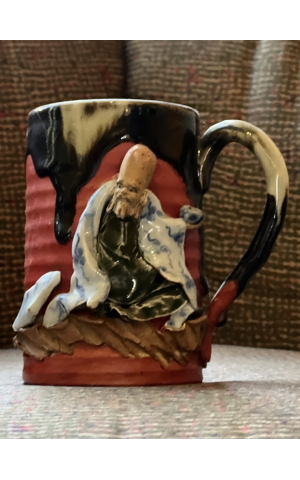
Sumida Gawa is a type of raku (or low-fire) Japanese pottery intended for export, created from the late 1800s until the beginning of World War II. Production was revived after the war and continues to this day. Sumida’s name comes from the Sumida River (gawa means river), which runs by the Asakusa pottery district near Tokyo. Sumida forms have heavy bodies and are lavishly decorated with realistic high-relief figures depicting flora, fauna, legendary figures and events, and people enjoying everyday activities.
Karp says, “Herb and I loved the same things and always supported one another.” After they married in 1947, they began to seriously collect exotic Sumida pieces. Over the years, they assembled a world-class, curated collection, became experts in all aspects of Sumida pottery, and turned their home into a showcase for the genre. Herbert, who passed away in 2018, built custom shelving. Their daughter, Lauri Lavine, remarks, “My father cleaned every piece of pottery himself. Much of it was displayed on a dining room wall, and children never sat on that side of the table, in fear of breaking or chipping a piece.”
The Karps were great admirers of all Chinese and Japanese art and fine crafts, and while adding to their Sumida trove, they simultaneously collected blue and white porcelain, uncommon decorative pieces, indigenous furniture, and iconic everyday items. Standouts are a handmade baby crib, an herb medicine cabinet, an opium set, a traveling makeup case, a Chinese screen spanning an entire wall, and a ceramic statue of a mounted warrior, a gift from Estelle to her husband.
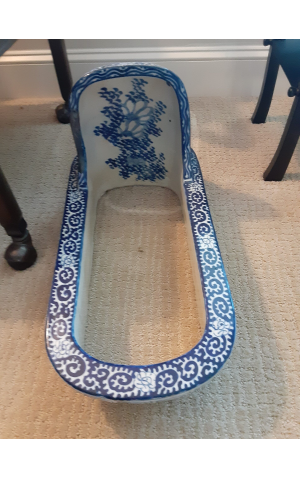
“We were always on the hunt for special things from Japan and China, as well as Sumida,” Karp recalls. “Antique dealers contacted us, and we also asked them to find things we wanted. Occasionally, we found pieces of Sumida that dealers couldn’t accurately identify. My husband was adept at wheeling and dealing when he was determined to acquire something.”
In Oct. 2001, Herbert Karp and another well-known Sumida collector and expert, Gardner Pond in San Francisco, produced a comprehensive book of all things Sumida, including 164 pages of sumptuous full-color photographs, the history of Chinese and Western influences, the themes and subjects decorating the pottery, a complete glossary of essential terminology, and biographies of major potters and identifying marks. “Sumida … according to us,” while a scholarly treatment of the genre, is also a personal homage to it. The introduction notes, “For those of us who collect Sumida, the charm is in its multitude of shapes, colorful glaze combinations and variety of applied decorations that express beauty, humor and folklore. Greater enjoyment of Sumida ware is gained by understanding what the potter was depicting as he applied the relief decorations.”
The definitive volume created and revived interest in Sumida ware in the U.S. and abroad. Japanese businessman Hiroichi Yokoyama, an enthusiastic admirer of Sumida, was given a copy of the book. He wrote, “I was overwhelmed by ‘Sumida … according to us,’ and I decided to publish it in Japanese.” Indeed, in Aug. 2006, more than 600 Japanese-language books were published by Yokoyama.
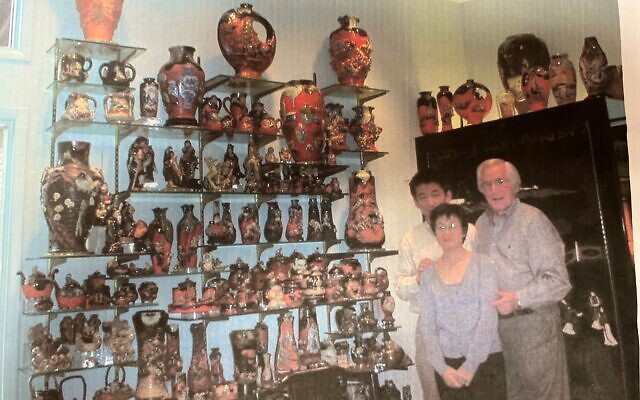
Before that, the Karps were visited in Atlanta by a man and woman representing the Japanese Cross Culture Trading Company, who assessed their collection for Yokoyama. Herbert reported to Pond, “He had to see almost every piece close up, even got down on the floor to see two shelves of bowls. He, in many instances, was able to tell me who did a piece and [more] about some of the pieces.” The couple convinced the Karps that the best of their collection must be seen in museums. Of their vast trove, the Karps sold the delegation 206 representative pieces, and Pond sold many of his best Sumida pieces, as well. The museum opened in 2007 in Nagoya, Japan.
In a letter to Pond, Karp wrote, “We are more than delighted that the collections stayed as a unit and were returning to their place of origin, and the publication of the book [in Japanese] satisfied our efforts to give Sumida its rightful place in the art pottery field.”
- Treasure Trove
- Community
- Chana Shapiro
- Estelle Karp
- Sumida Gawa
- Raku
- Japanese pottery
- World War II
- Sumida-base lamp
- Herbert Karp
- Japanese pottery assessors
- Sumida ware
- Buckhead
- Atlanta singer
- gourmet cook
- Japanese Art
- Chinese art
- Oriental art
- Estelle Mallon
- USO volunteer singer
- American troops
- Army
- military service
- Hadassah consignment shop
- Sumida River
- Asakusa pottery district
- Tokyo
- Sumida pottery
- Lauri Lavine
- blue and white porcelain
- uncommon decorative pieces
- indigenous furniture
- Japan
- China
- Antique dealers
- Gardner Pond
- Hiroichi Yokoyama
- Japanese Cross Culture Trading Company



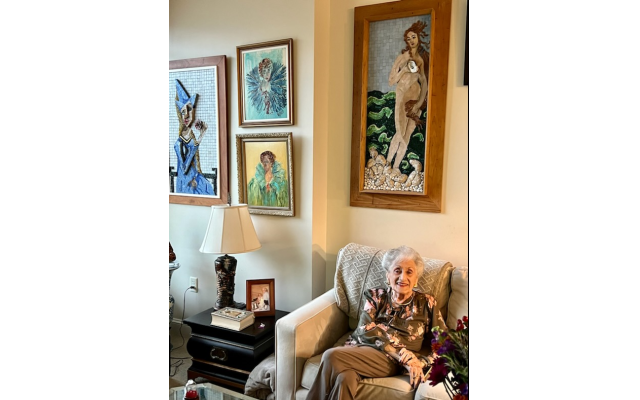
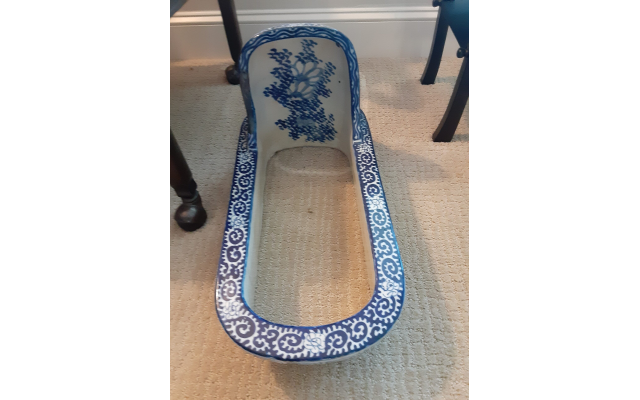
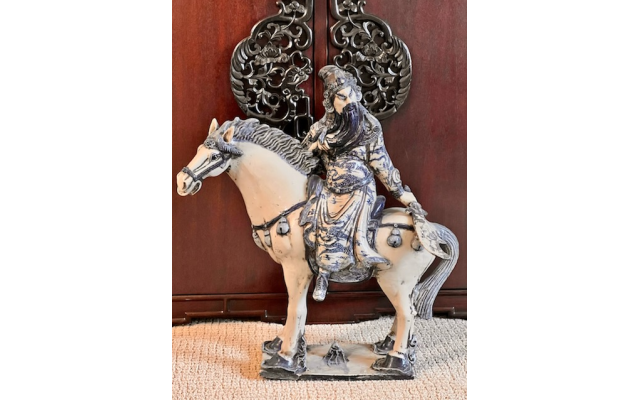
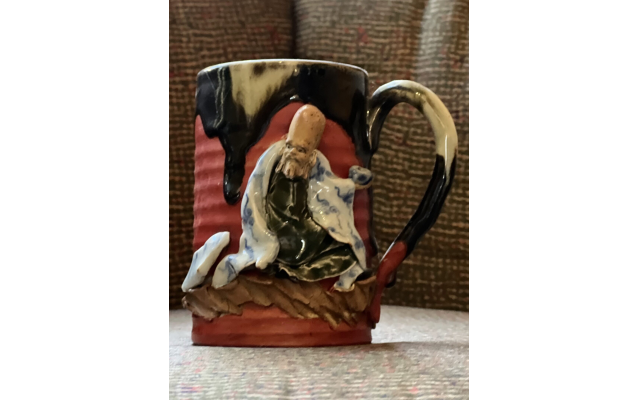
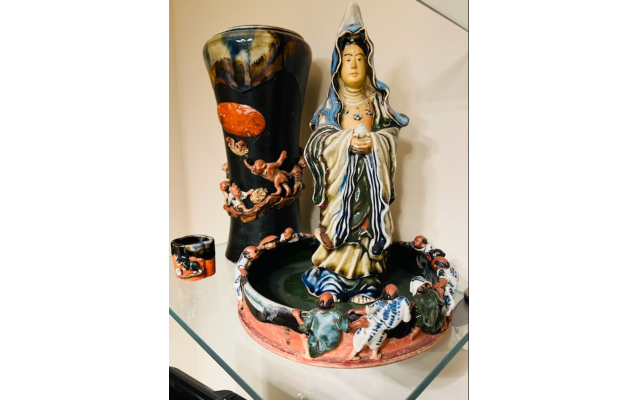
comments